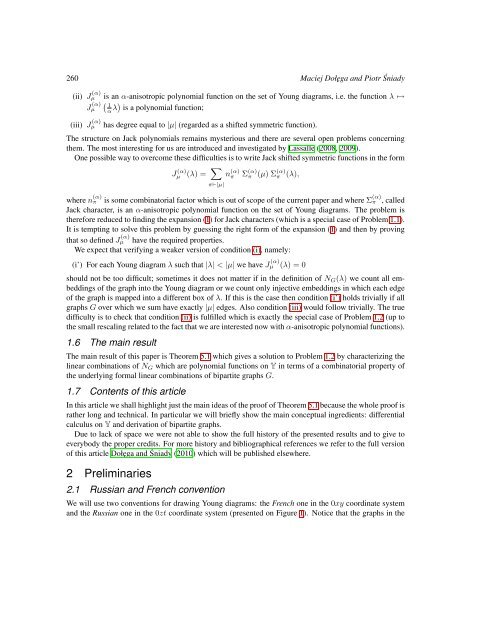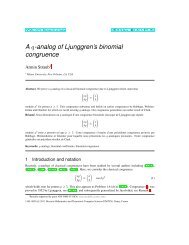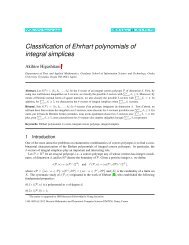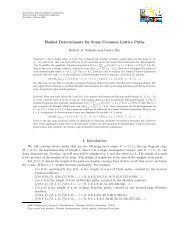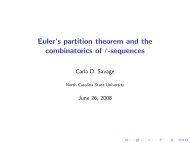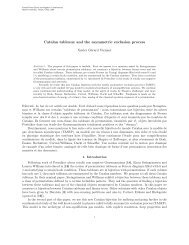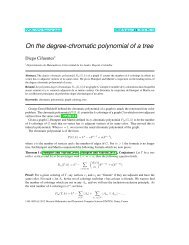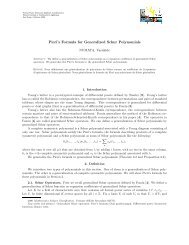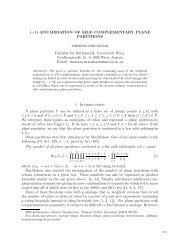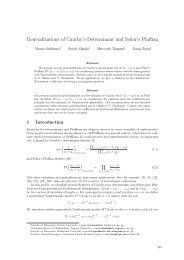Polynomial functions on Young diagrams arising from bipartite graphs
Polynomial functions on Young diagrams arising from bipartite graphs
Polynomial functions on Young diagrams arising from bipartite graphs
You also want an ePaper? Increase the reach of your titles
YUMPU automatically turns print PDFs into web optimized ePapers that Google loves.
260 Maciej Dołęga and Piotr Śniady<br />
(ii) J µ (α) is an α-anisotropic polynomial functi<strong>on</strong> <strong>on</strong> the set of <strong>Young</strong> <strong>diagrams</strong>, i.e. the functi<strong>on</strong> λ ↦→<br />
( 1<br />
α λ) is a polynomial functi<strong>on</strong>;<br />
J (α)<br />
µ<br />
(iii) J (α)<br />
µ has degree equal to |µ| (regarded as a shifted symmetric functi<strong>on</strong>).<br />
The structure <strong>on</strong> Jack polynomials remains mysterious and there are several open problems c<strong>on</strong>cerning<br />
them. The most interesting for us are introduced and investigated by Lassalle (2008, 2009).<br />
One possible way to overcome these difficulties is to write Jack shifted symmetric <str<strong>on</strong>g>functi<strong>on</strong>s</str<strong>on</strong>g> in the form<br />
where n (α)<br />
π<br />
J (α)<br />
µ (λ) = ∑<br />
π⊢|µ|<br />
n (α)<br />
π<br />
Σ (α)<br />
π<br />
(µ) Σ π<br />
(α) (λ),<br />
is some combinatorial factor which is out of scope of the current paper and where Σ (α)<br />
π , called<br />
Jack character, is an α-anisotropic polynomial functi<strong>on</strong> <strong>on</strong> the set of <strong>Young</strong> <strong>diagrams</strong>. The problem is<br />
therefore reduced to finding the expansi<strong>on</strong> (1) for Jack characters (which is a special case of Problem 1.1).<br />
It is tempting to solve this problem by guessing the right form of the expansi<strong>on</strong> (1) and then by proving<br />
that so defined J (α)<br />
µ have the required properties.<br />
We expect that verifying a weaker versi<strong>on</strong> of c<strong>on</strong>diti<strong>on</strong> (i), namely:<br />
(i’) For each <strong>Young</strong> diagram λ such that |λ| < |µ| we have J (α)<br />
µ (λ) = 0<br />
should not be too difficult; sometimes it does not matter if in the definiti<strong>on</strong> of N G (λ) we count all embeddings<br />
of the graph into the <strong>Young</strong> diagram or we count <strong>on</strong>ly injective embeddings in which each edge<br />
of the graph is mapped into a different box of λ. If this is the case then c<strong>on</strong>diti<strong>on</strong> (i’) holds trivially if all<br />
<strong>graphs</strong> G over which we sum have exactly |µ| edges. Also c<strong>on</strong>diti<strong>on</strong> (iii) would follow trivially. The true<br />
difficulty is to check that c<strong>on</strong>diti<strong>on</strong> (ii) is fulfilled which is exactly the special case of Problem 1.2 (up to<br />
the small rescaling related to the fact that we are interested now with α-anisotropic polynomial <str<strong>on</strong>g>functi<strong>on</strong>s</str<strong>on</strong>g>).<br />
1.6 The main result<br />
The main result of this paper is Theorem 5.1 which gives a soluti<strong>on</strong> to Problem 1.2 by characterizing the<br />
linear combinati<strong>on</strong>s of N G which are polynomial <str<strong>on</strong>g>functi<strong>on</strong>s</str<strong>on</strong>g> <strong>on</strong> Y in terms of a combinatorial property of<br />
the underlying formal linear combinati<strong>on</strong>s of <strong>bipartite</strong> <strong>graphs</strong> G.<br />
1.7 C<strong>on</strong>tents of this article<br />
In this article we shall highlight just the main ideas of the proof of Theorem 5.1 because the whole proof is<br />
rather l<strong>on</strong>g and technical. In particular we will briefly show the main c<strong>on</strong>ceptual ingredients: differential<br />
calculus <strong>on</strong> Y and derivati<strong>on</strong> of <strong>bipartite</strong> <strong>graphs</strong>.<br />
Due to lack of space we were not able to show the full history of the presented results and to give to<br />
everybody the proper credits. For more history and bibliographical references we refer to the full versi<strong>on</strong><br />
of this article Dołęga and Śniady (2010) which will be published elsewhere.<br />
2 Preliminaries<br />
2.1 Russian and French c<strong>on</strong>venti<strong>on</strong><br />
We will use two c<strong>on</strong>venti<strong>on</strong>s for drawing <strong>Young</strong> <strong>diagrams</strong>: the French <strong>on</strong>e in the 0xy coordinate system<br />
and the Russian <strong>on</strong>e in the 0zt coordinate system (presented <strong>on</strong> Figure 1). Notice that the <strong>graphs</strong> in the


